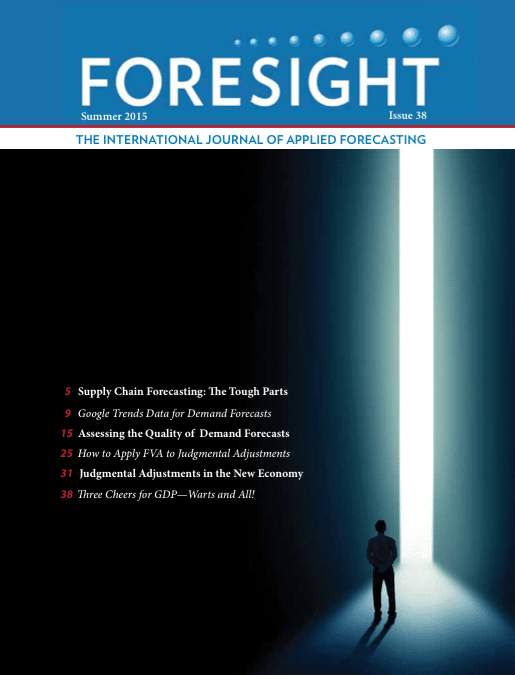FORESIGHT, Issue 38
$45.00
Description
Summer 2015
Articles
- Incorporating Google Trends Data Into Sales Forecasting by Tonya Boone, Ram Ganeshan, and Robert L. Hicks
Forecasters are learning that Internet search data can be valuable additions to their models. In this new study, Tonya, Ram, and Robert show specifically how to take search based data from Google Trends and build them into an individual firm’s sales forecasting model. Their case study shows the potential for improved accuracy. - A Better Way to Assess the Quality of Demand Forecasts by Steve Morlidge
In his last Foresight article, “Measuring the Quality of Intermittent-Demand Forecasts” in the Spring 2015 issue, Steve showed that certain common error metrics—the MAE and MAPE—can readily lead to the selection of inappropriate forecasting methods when demands are intermittent. Intermittent demands are a special case of asymmetric (skewed) distributions, for which Steve proposed an alternative metric, the bias-adjusted mean absolute error (BAMAE). In this article, Steve makes the argument that the BAMAE can serve as the most valid and appropriate error metric for any distribution of demands, symmetric or asymmetric. It is well worth giving this metric some thought. - Practical Considerations in Forecast Value Added (FVA) Analysis by Harpal Singh, Sanjiv Raman, and Eric Wilson
A business forecast is normally produced by applying overrides and modifications to an initial statistical forecast. Whether these adjustments to the statistical forecast improve forecast performance is always an important question – one to which the Forecast Value Added (FVA) concept can be applied. In this article, Harpal, Sanjiv, and Eric identify some of the practical issues in applying FVA analysis within a demand-management process. - Judgmental Adjustments to Forecasts in the New Economy by Manzoor Chowdhury and Sonia Manzoor
Manzoor and Sonia see an ever-increasing use of judgmental adjustments to statistical forecasts. In large part, they attribute this dependence to the complexities of the “new economy” in which, for example, there has been “a proliferation of distribution channels,” thus fragmenting the historical data on which statistical forecasting relies. So, despite improving technology and systems capabilities, forecasters and planners may face growing pressures to override their statistical forecasts, and perhaps greater difficulty than ever in meeting management’s expectations while keeping personal and organizational biases contained. - Forecaster in the Field: Pete Alle, Vice President, Supply Chain, Oberweis Dairy
- Three Cheers for GDP—Warts and All! by Ira Sohn
GDP – gross domestic product – is considered the most important and reliable measure of an economy’s performance, despite much criticism of its omissions. Ira Sohn expands upon the publication of two new books on the subject to highlight the development, virtues, and limitations of the GDP and our national income-accounting framework. - Hot New Research: When Forecasting in the Supply Chain Gets Tough by Paul Goodwin







